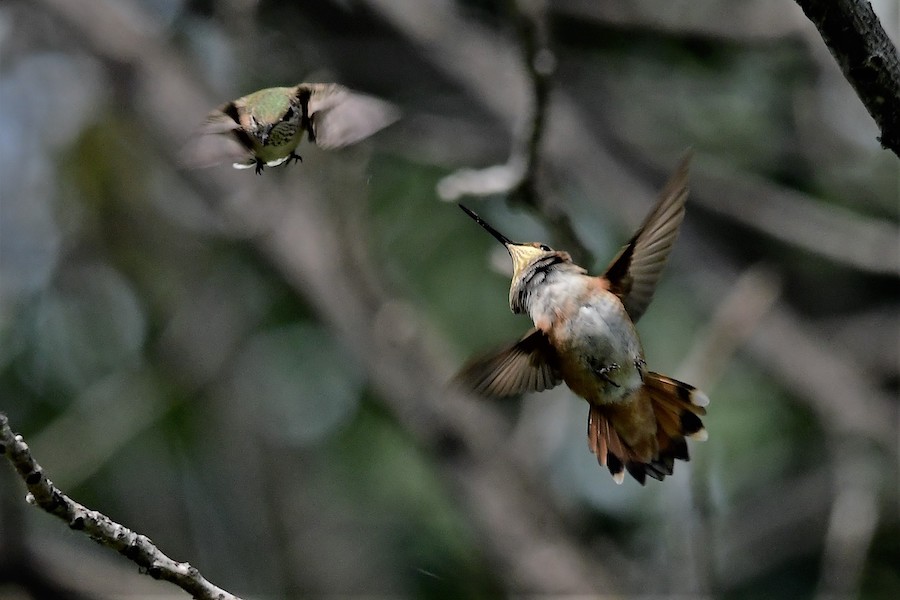My backyard was a battleground for hummingbirds as they fought for control of the feeders
Published at | Updated at
Sitting high in my back walnut tree, a male Rufous hummingbird maintained control of the feeder below. Any other hummingbird or even the occasional Bullock’s oriole that tried to steal a sip of nectar got attacked. He was king of the tree. Only his favorite female was able to drink with him. When he was at the feeder, the only thing that could drive him away were the Yellowjackets that were stealing from his favorite bar.
“Let the battles begin,” a friend’s Facebook page read with a picture of several hummingbirds battling over a feeder at his place. It is the right time of the year to have these smallest breeding bird species in North America visit feeders in your yards as the young “hummers” are joining their parents to gain some weight. In September the four most popular Idaho hummingbirds will make a 3900-mile flight to their winter range in Central and South America.
The four most popular species in Idaho are the Rufous, Calliope, Broad-tailed and the Black-chinned. My multiple backyard feeders mostly attract the Rufous and the Calliope while I will occasionally have a Broad-tailed come “singing” through my place. This summer, I had a pair of Rufous and a pair of Calliopes nest in different rose bushes at the back of my garden.
Because Rexburg does not have any mountains with forests nearby, we do not get a lot of hummingbirds here. But during the spring and fall migrations, up to 20 may visit area yards. The only bird feeders that I maintain during the summer months are the ones filled with nectar or sugar-water. I put them out in May and retire them after the first slight freeze or around the first of October when all hummers should be at their winter homes.
The most numerous hummingbirds we have near Rexburg are the Rufous. They are fearless and will attack anything that comes near their feeder and they love gardens with nectar feeders near them. The males breeding colors are a bright red throat with a rust-colored body while the females have a speckled throat with a white belly trimmed in rust.
The Calliope males have long magenta-colored feathers on their neck while the female looks almost exactly like the Rufous female. The Calliope are the smallest of the local species and love the conifer trees in your yard. They will also ambush other hummingbirds that try to feed on their feeder which causes major battles between them and the Rufous.
My favorite is the Broad-tailed hummer with the males bright red throat and their singing wings. As they fly, they make a buzzing sound much like a cricket. These are mountain birds that make fake attacks on me while I pick huckleberries as I steal their food. While leading some hikes for a youth conference near Palisades Reservoir recently, the Broad-tails kept entertaining us as we approached wild raspberry, Serviceberries and gooseberry patches. During the spring and fall migrations, a few will usually show up in my backyard. They don’t stay long because of the aggressive Rufous and Calliope. Locally, the Broad-tailed hummers are mistaken for Ruby-throated hummers, which are very rare in Idaho.
Because it loves the high mountains, the Broad-tailed survives the cold nights by entering a state of “torpor.” During the night, they will slow their heart rate down and their body temperature will drop until the sun comes up and warms their body.
The other local hummingbird is the Black-chin which is named incorrectly, as far as I’m concerned. When the sunlight hits the neck of the male, the chin is not black but a beautiful iridescent royal purple. When they’re out of the sun, they appear to have a black head.
All hummingbirds are attracted to red so the planting of red flowers like Anise sage, honeysuckle, hollyhocks and others will attract them to your yard. If you put out feeders, do so around your yard so that an aggressive bird can keep others away. Hummingbirds also remember from year to year where the feeders were, so keep hanging them in the same place each summer.
I have had a lot of fun with them this summer. Last Monday when it was cool, I spent several hours photographing them as they fought, fed and chased each other around. Hopefully, some have showed up in your yards and you have been able to watch them. Have a great week.

Living the Wildlife is brought to you by Yellowstone Teton Territory. Experience 7,500 square miles of untamed wilderness in Eastern Idaho's Yellowstone Teton Territory. Where majestic peaks meet endless adventure, your perfect outdoor escape is waiting. Start planning at YellowstoneTeton.com.






